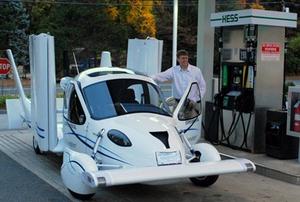Flying carsTerrafugia redesigns Transition flying car
The Federal Aviation Administration (FAA) allowed Terrafugia to add 110lb of extra weight to the original design of the Transition —thus allowing for more car-safety features to be added while still allowing the Transition to qualify as a “light sport” aircraft; even with the redesign, though, the Transition is beginning to look more like a single-seat rather than a two-seat aircraft, and there may yet be more weight gains on the horizon as the new design is built

Fueling up at a roadside service station // Source: travelizmo.com
The Terrafugia Transition, the first flying car likely to make it to the civilian market, has been redesigned following last year’s flight tests of a proof-of-concept prototype (“Flying car’s proof-of-concept testing now complete,” 6 June 2009 HSNW).
Lewis Page writes that the new design includes significant changes from the original Transition layout. The nose canard of the proof-of-concept vehicle is gone, and the tail empennage is now an open twin-boom affair rather than the former arrangement in which the twin tails and elevator emerged from a flattened rear fuselage.
Terrafugia says that the redesign was required as a result of lessons learned during flight and road tests of the proof-of-concept design. Since then the company has applied the Federal Aviation Administration (FAA) for 110lb of extra weight on the design – and the agency approved the request while still allowing the Transition to qualify as a “light sport” aircraft (“FAA brings flying car’s day closer,” 24 June 2010 HSNW). A light-sport pilot’s license is easier and cheaper to obtain than a normal private ticket.
Other flying cars have gotten around this by qualifying not as cars but some other, less restrictive road vehicle class on the ground - for instance as a motorcycle (“Flying motorcycle likely to take off next year,” 4 August 2009 HSNW). The Transition, though, will actually be a car in the eyes of the National Highway and Traffic Safety Administration (NHTSA).
Page says that the road-safety kit could also be useful in flight mode. The new Transition is to feature an emergency parachute intended to bring it down safely in the event even of some massive disaster such as the wings coming off.
Forced landing by parachute is not the ideal landing method and a rolling glide landing is preferable, especially if there is a strong wind blowing. A glide landing made into wind, which is the recommended procedure, often delivers a much lower ground speed on touchdown, usually resulting in better outcome for aircraft
